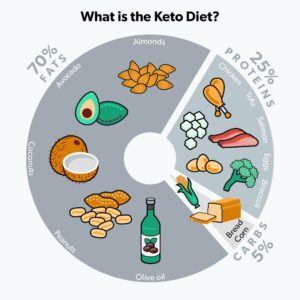One of the most common fad diets, the ketogenic or keto diet is widely used for many purposes. This diet has so many potential health benefits to offer that people can use in their miserable times. Heavily studied, this diet has sure gone a long way to cure children with epilepsy. This article will tell you all about the keto diet and whether you should try it.
Contents
What Is A Keto Diet?

The keto diet is a high-fat, low-carbohydrate diet that has been gaining popularity in recent years. The diet is based on the premise that by reducing carbohydrates and increasing fat intake, the body will enter a state of ketosis, where it will burn fat for energy instead of glucose. This can lead to weight loss and other health benefits.
Types
When it comes to keto diets, there are a few different types that you can choose from. The most popular type of keto diet is the Standard Ketogenic Diet (SKD), which is what most people think of when they think of a keto diet.
- Standard Ketogenic Diet (SKD): The SKD is a very low-carb, high-fat diet that involves eating very few carbs and replacing them with fats. This type of diet has been shown to be effective for weight loss, blood sugar control, and other health conditions. This diet contains 10% carbohydrates, 20% protein, and 70% fat.
- Cyclical Ketogenic Diet (CKD): Another type of keto diet is the Cyclical Ketogenic Diet (CKD), which is similar to the SKD but includes periods of higher carb intake. This type of diet can be helpful for those who are trying to build muscle mass or who need more carbs for exercise performance.
- Targeted Ketogenic Diet (TKD): Finally, there is the Targeted Ketogenic Diet (TKD), which is designed for athletes or people who are trying to optimize their workout performance. This type of diet involves eating more carbs around your workouts in order to improve energy levels and endurance.
- High Protein Ketogenic Diet: This diet is almost as same as SKD, but contains higher amounts of protein. This diet contains 60% fat, 5% carbohydrates, and 35% protein.
Uses
A keto diet can be used for a variety of purposes, including weight loss, bodybuilding, and managing diabetes.
Weight Loss
A keto diet can help you lose weight by keeping your body in a state of ketosis, which is a metabolic state where your body burns fat for energy instead of carbohydrates. In the absence of carbohydrates, our body starts burning fat, which further leads to ketones and hence the term ketosis. This leads to a reduction in weight as most of our energy comes from fat. The more we burn fat, the more we lose weight.
Bodybuilding
A keto diet can help you build muscle by providing your body with an alternative fuel source to glucose. When your body is in a state of ketosis, it is more efficient at using protein for muscle growth.
Diabetes Management
A keto diet can help you manage diabetes by keeping your blood sugar levels stable. When your blood sugar levels are stable, you are less likely to experience spikes in blood sugar that can lead to diabetic complications.
Epilepsy
The keto diet has been shown to be an effective treatment for epilepsy, especially in children. The diet works by reducing the body’s production of glucose, which is the main fuel source for seizures. Ketone bodies contribute to certain cerebral metabolic pathways, including those of the neurotransmitters glutamate and gamma amino butyric acid GABA and increase brain adenosine triphosphate ATP concentration, cerebral energy reserves, and GABA receptor sites, all of which are thought to contribute to the diet’s inhibitory effect on seizures.
The keto diet is typically divided into three phases: the induction phase, the maintenance phase, and the discontinuation phase.
The induction phase of the keto diet is the most restrictive and lasts for two weeks. During this time, you will consume only 20-50 grams of carbohydrates per day. This will cause your body to enter a state of ketosis, in which it will begin burning fat for fuel instead of glucose.
After two weeks in the induction phase, you will slowly reintroduce carbohydrates into your diet during the maintenance phase. The goal of this phase is to find your personal carb tolerance level – the number of carbs you can eat without triggering a seizure.
Once you have found your carb tolerance level, you can begin to slowly increase your carbs until you reach your desired level of carbohydrate intake. For some people, this may be as high as 100 grams per day; for others, it may be less than 30 grams per day.
What Foods Do You Eat In Keto?
Foods to eat in a ketogenic diet include:
- Low-Carb vegetables: Almost all green leafy vegetables are low in carbs such as drumsticks, asparagus, broccoli, cauliflower, spinach, kale, cabbage, Brussels sprouts, etc. Other vegetables that are low in carbs are bell peppers, okra, brinjal, etc.
- Low-Carb roots and tubers: Radish, beetroot, and carrot are low in carbs and can be added to the keto diet easily.
- Low-Carb fruits: Fruits usually contain carbs, but there are some options available for low-carb as well. These include avocados, gooseberries, guava, star fruit, strawberries, etc.
- Protein sources: Almost all protein sources are low in carbs and high in protein like fish, red meat, white meat, cheese, tofu, soybeans, etc.
What Foods Are Not Allowed On Keto?
When you’re following a keto diet, you need to be very careful about the foods you eat. There are a few food groups that you should avoid altogether, as they can kick you out of ketosis and stall your weight loss.
Here are the main food groups to avoid on a keto diet:
- Grains – This includes all forms of wheat, rice, oats, barley, etc. You should also avoid any processed foods made with grains, such as bread, pasta, cereals, and baked goods.
- Sugar – This includes all forms of sugar, honey, agave syrup, etc. You should also avoid any foods or drinks that are high in sugar, such as candy, desserts, fruit juices, and sugary sodas.
- Legumes – This includes all beans (such as black beans, kidney beans, and lentils), peas (such as chickpeas), and peanuts. You should also avoid any processed foods made with legumes (such as soy products), as these can be high in carbs and difficult to digest.
Possible Side Effects
If you are thinking about starting a keto diet, it is important to be aware of the possible side effects. While the keto diet has many potential benefits, there are also some potential risks.
- Keto Flu: The most common side effect of the keto diet is the “keto flu.” This is a temporary condition that can occur when your body adjusts to burning fat for fuel. Symptoms of the keto flu include fatigue, headaches, nausea, and difficulty sleeping. These symptoms usually resolve within a few days to a week.
- Constipation: Another potential side effect of the keto diet is constipation. This is caused by the reduced intake of fiber in the diet. To alleviate constipation, be sure to drink plenty of water and eat high-fiber foods like leafy greens and vegetables.
- Ketoacidosis: Although rare, Ketoacidosis is a life-threatening condition that can occur when you are on a ketogenic diet. It happens when your body produces too many ketones and not enough insulin. This can lead to a build-up of acids in your blood, which can be fatal. Symptoms of ketoacidosis include nausea, vomiting, abdominal pain, shortness of breath, fruity-smelling breath, and confusion. If you think you are experiencing these symptoms, it is important to seek medical help immediately.
- Medical Conditions: There are also some rare but serious side effects that can occur with the keto diet. These include kidney stones, pancreatitis, and elevated cholesterol levels. If you experience any of these side effects, it is important to talk to your doctor right away.
Conclusion
The keto diet is a high-fat, low-carbohydrate diet that has been shown to offer numerous health benefits. If you are looking to improve your overall health or lose weight, the keto diet may be a good option for you. This guide has provided you with all the information you need to get started on the keto diet, including what foods to eat and avoid, how to stick to the diet, and some of the potential risks and side effects associated with it. With careful planning and execution, the keto diet can help you achieve your health goals.
Consider contacting Mantra Care for additional information on weight loss. With the support of our weight loss programs, you can achieve your optimum weight. You can also get in touch with their nutrition experts through our online nutrition counseling, who can guide you through the process and help you achieve your fitness goals. Download our Fitness App to know more about us. We provide effective Diet plans for women as well.


